On centripetal flows of entities in scale‐free networks with nodes of finite capability
Jul 4, 2014·
 ,,·
0 min read
,,·
0 min read
J.F. Valenzuela
C. Monterola
E.F. Legara
X. Fu
S.M. Goh

Abstract
We examine the transmission of entities from the peripheries of scale‐free networks toward their centers when the nodes of the network have finite processing capabilities. We look at varying network utilization, U and find that clogging of the network sets in after a threshold value has been exceeded, and that the congestion sets in at the downstream nodes (those nearer to the collector) having large numbers of upstream neighbors. Investigation of the question of the degree of correlation of several characteristics of scale‐free networks (such as the average path length to the collector $l_{min}$ and the average clustering coefficient <$c$> with the dynamics of centripetal flow in them reveals a negative answer: any correlation is indirect and will manifest in the number of producer nodes (which dictate the effective heaviness of the flow) and the interconnectedness of the feeder nodes, those nodes which are immediate neighbors of the collector node. An examination of reinforcement strategies shows dramatic improvements in both the finishing rate, $\lambda_f$ and the average total transmission time, <$t_f$> when the more centrally‐placed nodes are reinforced first, showing that the entities spend a large amount of their lifetime waiting in line at those nodes (which constitute the bottlenecks in the network) compared to the nodes in the periphery. Our results reinforce the importance of a network’s hubs and their immediate environs, and suggest strategies for prioritizing elements of a network for optimization.
Type
Publication
Complexity